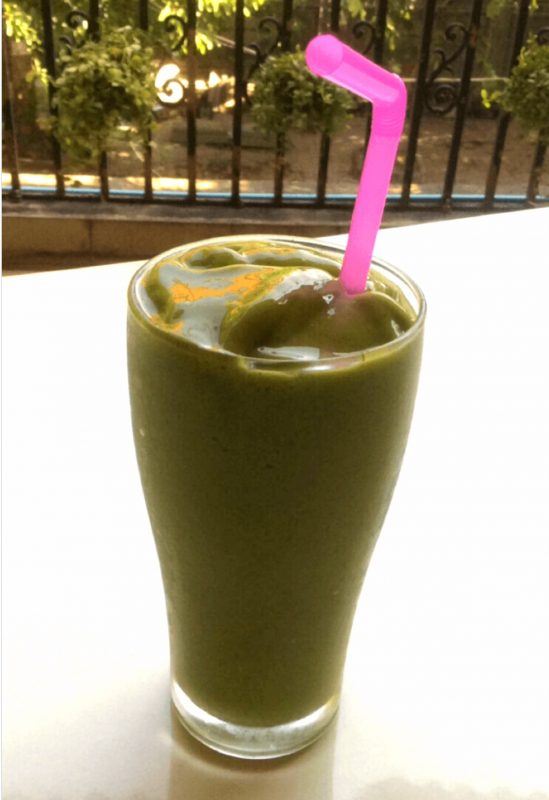World Of Smoothies

I was reading a trashy article about a celebrity who had lost weight. Diet: two store-bought smoothies and a big green salad daily. About one thousand five hundred calories a day.
I thought, OK, that’s terrible. But I do love a good smoothie. Nothing wrong with pure fruit. Especially if you are trying to lose weight. They certainly are filling.
And since I live in Cambodia, there’s a tremendous amount of awesome tropical fruit available. So I bought a $25 blender and gave it a try. I’ve been making an effort to be a healthy boy and in the last six to eight months I have made hundreds of smoothies.
I’ve had good results (mango and passionfruit) and disasters (beetroot stains everything).
Some observations on the process:
1. Surprise!
Smoothie-making can be a little more labor-intensive than you might think, at first. (It’s just fruit right, how hard could it be?)
I have it down to a science; it’s about planning and tools.
If you have time to go to the market, freeze fruit, blend it, freeze it, thaw it out, blend it, drink it, and clean your blender? Lucky you. There is a reason that smoothie shops / store bought smoothies are popular. Smoothies are great. But be aware they can be more work than you might initially think.
2. Color!
Juice sellers here in Cambodia know about branding. They sell juices in primary colors. Bright red, green, yellow, orange. Same with smoothies; a smoothie that tastes delicious blindfolded can look like mud, but something about our instincts want it *colorful*.
Trust this instinct. Ever bought a smoothie from a store, loaded with sugar? Didn’t it look good? You want to beat that marketing pitch from your own home. If you want to save money and be healthy by making your own smoothie, make it bright and colorful. I will throw a few Kale leaves in to make my Apple-Kiwi smoothie bright green. Even if it’s just for you, presentation matters. Treat yourself.
3. Source!
Buy your fruit, grind it up. It’s best to have it frozen in small bits before. I prefer fresh fruit over ‘fruit from concentrate’. Fiber tends to buffer you from a sugar rush. I can certainly feel the difference.
I buy fresh fruit in the local market. There’s amazing local fruit here in Cambodia for super cheap. I chop it up and blend it, then pour it into little four ounce plastic cups. (I re-wash and re-use). I find these little cups useful; I can mix and match ingredients for a 16 ounce smoothie. I run warm water on the outside of the cups, then after a few minutes dump them in the blender. Sometimes I will add a cup of drinking yogurt.
4. Blend!
I recommend a 50 / 50 ratio of water to frozen items. I use those little plastic cups for on-the-fly measuring.
As long as you give your frozen items a few minutes to warm up, you will get fairly good consistency. Between doing a Mocha Frappe in the morning and a fruit smoothie in the afternoon, my blender gets a workout.
5. Pour!
As mentioned earlier: you want to beat expensive store-bought smoothies. Make it ‘Instagram Worthy’. Get a nice glass. Pour it in. Use a metal or plastic straw. (I find I really want a plastic straw. I have big ones that I clean and re-use with the ‘pipe cleaner’ for metal straws.)
6. Dunk!
As you are pouring your smoothie, take the blender jug with your other arm and and dunk it under your tap.
A fruit (and/or vegetable) smoothie is full of fiber. It’s sticky and goopy and good for you when it’s in your body. When it’s outside your body, it’s a horror for you to clean, so get that jug soaking immediately.
7. Enjoy!
I find that a smoothie is super filling. it’s a great snack especially on a warm day. In a pinch, a big 16 – 24 ounce smoothie can serve as a meal although I wouldn’t recommend a practice of it.
Trust your instincts; simply take your favorite fruit tastes and work from there.
I am confident I could rival the quality of any restaurant made smoothie in Phnom Penh, providing it is not made from Beetroot. 😉
I have tons of smoothie photos; more on my PixelFed.